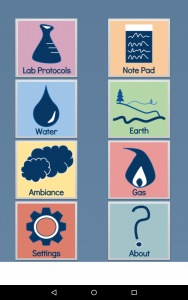This past week I have done a lot with the Android application, Field Day. I’ve implemented the basic architecture that I think we are going to use.
It makes use of Android ‘Fragments’ class. Fragments were introduced to make it nicer when building UIs. Before Fragments (introduced in API 11), whenever a new screen on the Android device was shown, a new Activity was created. Even if only one thing on the page changed, you needed to create a new activity. That meant that there were many lifecycles that needed to be tracked and maintained. That’s drained the battery and made the code more complicated than it needed to be. The Activity lifecycle is complicated. With Fragments, you can easily swap out parts of a UI and still stay in the same lifecycle. The activity that created the fragment controls its lifecycle. There’s no extra ones that need to be maintained.
Right now, there are only about 3 activities, and 5 or 6 fragments. The main screen buttons, and when you click on ‘Take a Sample’ or ‘Lab Notebook’ are all fragments with one activity maintaining them. Once a specific sample type is clicked then the SensorSample.java activity is created. There are parts of the SensorSample activity that are going to be the same no matter what type of sample we are taking. That’s why those are also fragments. Code/UI elements that will be the same for all — Geocoordinate, for example — are on the SensorSample activity’s layout file, but there’s a FrameLayout in there that can be swapped out depending on the type of sample. It really helps with stopping the creation of repetitive code.
In the SensorSample activity, I’ve already implemented a LocationListener and Manager that will listen and update the user’s location. That will be used for the Geocoordinate. It doesn’t get written to the database yet, but I have implemented in both the code and UI so it shows up and does change. I tested it!

